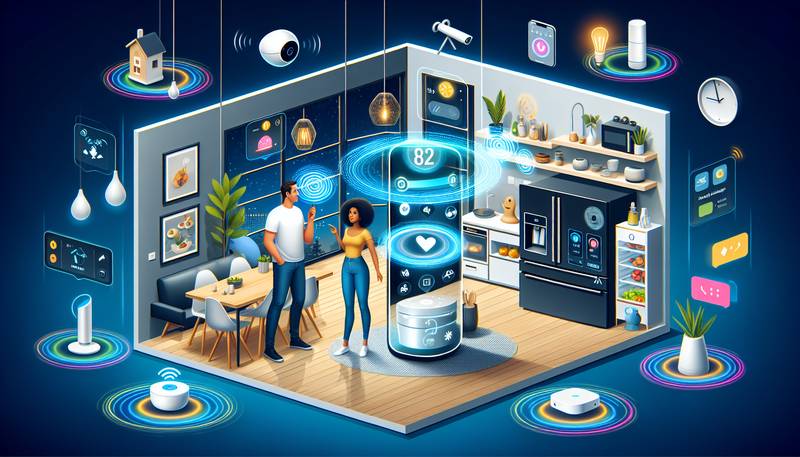Setting Up a Smart Home: A Step-by-Step Guide

Are you ready to join the smart home revolution? It's an exciting time to embrace technology that can make your daily life more convenient, efficient, and secure. But where do you start? With an array of products and platforms to choose from, setting up a smart home can seem daunting. Fear not! In this comprehensive guide, we'll break down the steps to creating your very own smart home oasis. We promise to keep it informative, engaging, and most importantly, simple to follow. So let's gear up and get started on this high-tech journey!
Understanding Smart Home Basics
At its core, a smart home is a living space where appliances and devices can be automatically controlled remotely from anywhere with an internet connection, using a mobile or other networked device. These devices are interconnected through the internet, allowing you to control functions such as home security, lighting, temperature, and even your coffee maker. First, let's discuss the concept of IoT (Internet of Things), which is the backbone of smart home technology. IoT refers to the network of physical objects—"things"—that are embedded with sensors, software, and other technologies for the purpose of connecting and exchanging data with other devices and systems over the internet.
Now, for these devices to communicate, they need a common language. This is where protocols like Zigbee, Z-Wave, Wi-Fi, and Bluetooth come into play. These protocols determine how devices talk to each other and to the hub, which acts as the brain of your smart home, processing information and sending commands. Choosing devices that are compatible with the same protocol ensures a streamlined and harmonious system.
Choosing the Right Smart Home Ecosystem
Think of the smart home ecosystem as the operating system for your home. It's a crucial element, as all of your devices will need to be compatible with this platform. The major players in the market include Amazon Alexa, Google Assistant, and Apple HomeKit, amongst others. Each system has its own strengths and might be better suited for different users depending on their needs. For instance, Amazon Alexa has a wide range of compatible devices and is preferred for voice-control functionality, while Apple HomeKit is known for its robust security features and seamless integration with Apple products. Meanwhile, Google Assistant shines with its search functionality and natural language processing.
To choose the right ecosystem, consider which devices you already own and your current usage patterns. If you're heavily invested in Apple's ecosystem, it makes sense to go with HomeKit. However, if you’re looking for a more open and flexible platform, Google and Amazon might be more your speed. Consider the types of devices you plan to connect; not all smart home gadgets work with every platform. Make a checklist of your must-haves and make sure the ecosystem you choose supports them all.
Smart Home Device Selection
Once you've selected your ecosystem, it's time to choose your devices. Start with the basics: smart lighting, smart thermostats, and smart locks are widely supported and can immediately add convenience and energy savings to your household. Smart lights, such as Philips Hue or LIFX, can be programmed to turn on and off at specific times, change color to set the mood, and even sync with your music. Smart thermostats, like those from Nest or Ecobee, learn your temperature preferences and adjust accordingly while helping to lower your energy bill. Smart locks offer keyless entry and can integrate with your alarm system for heightened security.
Don't forget about entertainment – a smart TV or smart speakers can add a high level of convenience and enjoyment to your home. For those interested in home security, there are plenty of smart cameras, sensors, and alarm systems to give you peace of mind. As you select devices, remember to check for compatibility with your chosen ecosystem and with each other for the best integrated experience.
Setting Up Your Smart Home Hub
Think of the hub as the maestro of your smart home orchestra, controlling various devices and making them work together harmoniously. The hub connects to your home's Wi-Fi network and interacts with all your smart devices. Some ecosystems, like Google Assistant and Amazon Alexa, rely on cloud-based hubs, which means that they use the cloud to communicate with your devices, while others may require a physical hub that you'll have to connect to your router.
Setting up the hub involves a few basic steps: first, unbox the hub and plug it into power. Next, connect it to your Wi-Fi network, usually through a companion app on your smartphone. This app will be the control center for all your smart home devices – from setting up to daily operation. The app will guide you through the process of adding new devices, usually by detecting them automatically once they're powered on. Ensure that the firmware is updated for the most recent features and for security reasons, which is typically handled within the app itself.
Once your hub is up and running, you'll want to spend some time getting acquainted with its features. Explore the app, customize your settings, and begin adding your devices. In the following sections, we'll cover how to connect each type of device to your hub, creating a dynamic and customizable smart home environment for you and your family to enjoy.
Connecting and Configuring Devices
With your smart home hub up and running, it's time to introduce your smart devices to the system. Most devices pair with your hub through a straightforward process facilitated through your smartphone app. Typically, you will choose to 'Add Device' in the app, select the device's brand, and follow the on-screen instructions to pair it to the hub. Some devices will automatically be detected and appear onscreen for an even smoother experience.
When adding devices, it's a good practice to assign them to specific rooms or zones in your home. This logical grouping will make it easier to control individual devices or set up operations that affect entire areas with a single command. Once your devices are connected, you may need to configure them to your liking. This could mean setting your preferred temperature range for your smart thermostat, customizing light schedules and colors, or setting sensitivity levels on your smart security cameras.
As you continue adding devices, regularly check your app for firmware updates. Companies often release new features, enhancements, and security upgrades through these updates. When you've finished connecting your devices, walk through your home to test them out. Use your hub's app or voice commands, if available, to ensure everything works as expected. If any issues arise, consult the device's user manual or customer support for assistance. With everything synced and configured, you'll begin to see your smart home come alive with responsive, intuitive technology.
Creating Smart Home Automations
The power of a smart home lies in its ability to automate tasks to match your lifestyle, and this is where the real fun begins. Based on 'Triggers' (like time of day, your location, or sensor readings) and 'Actions' (like turning on lights or adjusting the thermostat), automations can make your life more comfortable and your home more energy-efficient.
First, identify routines that you perform regularly and would like to automate. Common starting points include a 'Welcome Home' automation, where your lights turn on and your favorite music begins to play when you arrive home, or a 'Goodnight' routine that secures the house and turns off unnecessary electronics as you prepare for bed. To create an automation, go to the relevant section in your smart home app, select 'Create a New Automation' or 'Add a Routine,' and customize it to your preferences.
When designing automations, consider how different devices can work together to achieve the desired outcome. For example, motion sensors can trigger smart bulbs to illuminate a pathway to your bathroom at night, or a door sensor can inform your thermostat to power down when the house is empty. The potential combinations are endless, so experiment with different automations to see what works best for you and your family. Just remember: the more complex your automation, the more you'll have to maintain. Keep it straightforward at first, and expand as you become more comfortable with the technology.
Troubleshooting and Maintenance
Even the best technology can have its off days, but don't let that discourage you. If a device isn't responding as it should, here are a few troubleshooting tips: first, make sure the device is powered on and connected to your network. Check for and install any pending updates, as these often fix known issues. Rebooting your device or hub can also clear up many common problems. If these steps don't work, reset your device to its factory settings and reconnect it to your system.
Maintenance is equally important to keep your smart home running smoothly. Clean your devices regularly, pay attention to battery life indications, and check your system's security settings often. If you keep your devices in good order and stay vigilant about updates, your smart home will serve you well for many years.
Enjoying Your Smart Home
At this point, you can proudly call yourself a smart homeowner. You've selected and installed an array of devices that not only increase your home's safety and efficiency but also its convenience and cool factor. With your home's new-found intelligence, everyday tasks are automated, and control over your living space is at your fingertips—or even your voice!
As you live with your smart home, keep exploring its capabilities. The beauty of smart home tech is that it's always evolving, with new devices and features being introduced regularly. Stay current with the latest trends, and don't be afraid to add or adjust your system as new needs arise. Above all, enjoy the experience. After all, having a smart home is as much about delight as it is about utility. Here's to your home being a little bit smarter—and your life a little bit easier.


